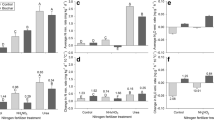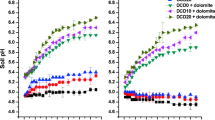Abstract
Little information is available on the effects of urease inhibitor, N-(n-butyl)thiophosphoric triamide (NBPT), and nitrification inhibitor, dicyandiamide (DCD), on nitrous oxide (N2O) emissions from fluvo-aquic soil in the North China Plain. A field experiment was conducted at the Fengqiu State Key Agro-Ecological Experimental Station, Henan Province, China, to study the influence of urea added with NBPT, DCD, and combination of both NBPT and DCD on N2O emissions during the maize growing season in 2009. Two peaks of N2O fluxes occurred during the maize growing season: the small one following irrigation and the big one after nitrogen (N) fertilizer application. There was a significant positive relationship between ln [N2O flux] and soil moisture during the maize growing season excluding the 11-day datasets after N fertilizer application, indicating that N2O flux was affected by soil moisture. Mean N2O flux was the highest in the control with urea alone, while the application of urea together with NBPT, DCD, and NBPT + DCD significantly lowered the mean N2O flux. Total N2O emission in the NBPT + DCD, DCD, NBPT, and urea alone treatments during the experimental period was 0.41, 0.47, 0.48, and 0.77 kg N2O–N ha−1, respectively. Application of urea with NBPT, DCD, and NBPT + DCD reduced N2O emission by 37.7%, 39.0%, and 46.8%, respectively, over urea alone. Based on our findings, the combination of DCD and NBPT together with urea may reduce N2O emission and improve the maize yield from fluvo-aquic soil in the North China Plain.



Similar content being viewed by others
References
Abdalla M, Jones M, Williams M (2010) Simulation of N2O fluxes from Irish arable soils: effect of climate change and management. Biol Fertil Soils 46:247–260
Asing J, Saggar S, Singh J, Bolan NS (2008) Assessment of nitrogen losses from urea and organic manure with and without nitrification inhibitor, dicyandiamide, applied to lettuce under glasshouse conditions. Aust J Soil Res 46:535–541
Barton L, Kiese R, Gatter D, Butterbach-Bahl K, Buck R, Hinz C, Murphy DV (2008) Nitrous oxide emissions from a cropped soil in a semi-arid climate. Glob Change Biol 14:177–192
Blennerhassett JD, Quin BF, Zaman M, Ramakrishnan C (2006) The potential for increasing nitrogen responses using Agrotain treated urea. Proc N Z Grassl Assoc 68:297–301
Boeckx P, Xu XK, Van Cleemput O (2005) Mitigation of N2O and CH4 emission from rice and wheat cropping systems using dicyandiamide and hydroquinone. Nutr Cycl Agroecosyst 72:41–49
Cai GX, Fan XH, Yang Z, Zhu ZL (1998) Gaseous loss of nitrogen from fertilizers applied to wheat on a calcareous soil in North China Plain. Pedosphere 8:45–52
Cai GX, Chen DL, White RE, Fan XH, Pacholski A, Zhu ZL, Ding H (2002a) Gaseous nitrogen losses from urea applied to maize on a calcareous fluvo-aquic soil in the North China Plain. Aust J Soil Res 40:737–748
Cai GX, Chen DL, Ding H, Pacholski A, Fan XH, Zhu ZL (2002b) Nitrogen losses from fertilizers applied to maize, wheat and rice in the North China Plain. Nutr Cycl Agroecosyst 63:187–195
Cavigelli MA, Robertson GP (2001) Role of denitrifier diversity in rates of nitrous oxide consumption in a terrestrial ecosystem. Soil Biol Biochem 33:297–310
Dalal RC, Gibson IR, Menzies NW (2009) Nitrous oxide emission from feedlot manure and green waste compost applied to vertisols. Biol Fertil Soils 45:809–819
Di HJ, Cameron KC (2004) Effects of temperatures and application rate of a nitrification inhibitor, dicyandiamide (DCD) on nitrification rate and microbial biomass in a grazed pasture soil. Aust J Soil Res 42:927–932
Di HJ, Cameron KC, Sherlock RR (2007) Comparison of the effectiveness of a nitrification inhibitor, dicyandiamide, in reducing nitrous oxide emissions in four different soils under different climatic and management conditions. Soil Use Manage 23:1–9
Ding WX, Cai Y, Cai ZC, Yagi K, Zheng XH (2007a) Nitrous oxide emissions from an intensively cultivated maize-wheat rotation soil in the North China Plain. Sci Total Environ 373:501–511
Ding WX, Yagi K, Akiyama H, Sudo S, Nishimura S (2007b) Time-lagged induction of N2O emission and its trade-off with NO emission from a nitrogen fertilized Andisol. Soil Sci Plant Nutr 53:362–372
Dobbie KE, Smith KA (2003) Impact of different forms of N fertilizer on N2O emissions from intensive grassland. Nutr Cycl Agroecosyst 67:37–46
Dong Y, Scharffe D, Qi YC, Peng GB (2001) Nitrous oxide emissions from cultivated soils in the North China Plain. Tellus 53B:1–9
Du ZL, Liu SF, Li KJ, Ren TS (2009) Soil organic carbon and physical quality as influenced by long-term application of residue and mineral fertiliser in the North China Plain. Aust J Soil Res 47:585–591
Fan XH, Zhu ZL (1998) Investigation on the fate of nitrogen fertilizer and its nitrification-denitrification loss in summer maize on calcareous fluvo-aquic soils. In: Fu JP, Xu FA (eds) Agricultural researches on the Huanghuaihai Plain. Meteorological, Beijing, pp 48–51
Firestone MK, Davidson EA (1989) Microbiological basis of NO and N2O production and consumption in soil. In: Andreae MO, Schimel DS (eds) Exchange of trace gases between terrestrial ecosystems and the atmosphere. Wiley, New York, pp 7–21
Forster P, Ramaswamy V, Artaxo P, Berntsen T, Betts R, Fahey DW, Haywood J, Lean J, Lowe DC, Myhre G, Nganga J, Prinn R, Raga G, Schulz M, Van Dorland R (2007) Changes in Atmospheric Constituents and in Radiative Forcing. In: Solomon S, Qin D, Manning M (eds) Climate change 2007: the physical science basis, contribution of working group I to the fourth assessment report of the intergovernmental panel on climate change. Cambridge University Press, Cambridge, pp 129–234
Gioacchini P, Nastri A, Marzadori C, Giovannini C, Antisari LV, Gessa C (2002) Influence of urease and nitrification inhibitors on N losses from soils fertilized with urea. Biol Fertil Soils 36:129–135
Gong W, Yan XY, Wang JY, Hu TX, Gong YB (2009) Long-term manure and fertilizer effects on soil organic matter fractions and microbes under a wheat-maize cropping system in northern China. Geoderma 149:318–324
Granli T, Bøckman OC (1994) Nitrous oxide from agriculture. Norwegian J Agric Sci Suppl 12:7–128
Inubushi K, Naganuma H, Kitahara S (1996) Contribution of denitrification and autotrophic and heterotrophic nitrification to nitrous oxide production in andosols. Biol Fertil Soils 23:292–298
IPCC (2007) Climate change 2007: Agriculture. Available at: http://www.ipcc.ch/pdf/assessment-report/ar4/wg3/ar4-wg3-chapter8.pdf. Accessed 25 Feb 2008
Kelly KB, Phillips FA, Baigent R (2008) Impact of dicyandiamide application on nitrous oxide emissions from urine patches in Northern Victoria, Australia. Aust J Exp Agric 48:156–159
Li XL, Zhang GB, Xu H, Cai ZC, Yagi K (2009) Effect of timing of joint application of hydroquinone and dicyandiamide on nitrous oxide emission from irrigated lowland rice paddy field. Chemosphere 75:1417–1422
Ma WK, Schautz A, Fishback LAE, Bedard-Haughn A, Farrell RE, Siciliano SD (2007) Assessing the potential of ammonia oxidizing bacteria to produce nitrous oxide in soils of a high arctic lowland ecosytstem on Devon Island, Canada. Soil Biol Biochem 39:2001–2013
Majumdar D, Kumar S, Pathak H, Jain MC, Kumar U (2000) Reducing nitrous oxide emission from an irrigated rice field of North India with nitrification inhibitors. Agric Ecosyst Environ 81:163–169
Majumdar D, Pathak H, Kumar S, Jain MC (2002) Nitrous oxide emission from a sandy loam Inceptisol under irrigated wheat in India as influenced by different nitrification inhibitors. Agric Ecosyst Environ 91:283–293
Manunza B, Deiana S, Pintore M, Gessa C (1999) The binding mechanism of urea, hydroxamic acid and N-(n-butyl)-phosphoric triamide to the urease active site: a comparative molecular dynamics study. Soil Biol Biochem 31:789–796
Menéndez S, Merino P, Pinto M, González-Murua G, Estavillo JM (2009) Effect of N-(n-butyl) thiophosphoric triamide and 3, 4-dimethylpyrazole phosphate on gaseous emissions from grasslands under different soil water contents. J Environ Qual 38:27–35
Meng L, Ding WX, Cai ZC (2005) Long-term application of organic manure and nitrogen fertilizer on N2O emissions, soil quality and crop production in a sandy loam soil. Soil Biol Biochem 37:2037–2045
Merino P, Estavillo JM, Graciolli LA, Pinto M, Lacuesta M, Munoz-Rueda A, Gonzalez-Murua C (2002) Mitigation of N2O emissions from grassland by nitrification inhibitor and Actilith F2 applied with fertilizer and cattle slurry. Soil Use Manage 18:135–141
Prasad R, Power JF (1995) Nitrification inhibitors for agriculture, health, and the environment. Adv Agron 54:233–281
Shaw LJ, Nicol GW, Smith Z, Fear J, Prosser JI, Baggs EM (2006) Nitrosospira spp. can produce nitrous oxide via a nitrifier denitrification pathway. Environ Microbiol 8:214–222
Silver WL, Herman DJ, Firestone MK (2001) Dissimilatory nitrate reduction to ammonium in upland tropical forest soils. Ecology 82:2410–2416
Tiedje JM (1988) Ecology of denitrification and dissimilatory nitrate reduction to ammonium. In: Zehnder AJB (ed) Biology of anaerobic microorganisms. Wiley, New York, pp 179–244
Tiessen KHD, Flaten DN, Bullock PR, Burton DL, Grant CA, Karamanos RE (2006) Transformation of fall-banded urea: application date, landscape position, and fertilizer additive effects. Agron J 98:1461–1470
Vogeler I, Blard A, Bolan N (2007) Modelling DCD effect on nitrate leaching under controlled conditions. Aust J Soil Res 45:310–317
Webster EA, Hopkins DW (1996) Contribution from different microbial processes to N2O emission from soil under different moisture regimes. Biol Fertil Soils 22:331–335
Williams AP, Edwards-Jonesa G, Jonesa DL (2009) In-vessel bioreduction provides an effective storage and pre-treatment method for livestock carcasses prior to final disposal. Bioresour Technol 100:4032–4040
Wrage N, Velthof GL, van Beusichem LM, Oenema O (2001) Role of nitrifier denitrification in the production of nitrous oxide. Soil Biol Biochem 33:1723–1732
Xing GX (1998) N2O emission from cropland in China. Nutr Cycl Agroecosyst 52:249–254
Xu XK, Boeckx P, Van Cleemput O, Zhou LK (2002) Urease and nitrification inhibitors to reduce emissions of CH4 and N2O in rice production. Nutr Cycl Agroecosyst 64:203–211
Xu XK, Zhou LK, Van Cleemput O, Wang ZJ (2000) Fate of urea-15 N in a soil-wheat system as influenced by urease inhibitor hydroquinone and nitrification inhibitor dicyandiamide. Plant Soil 220:261–270
Zaman M, Blennerhassett JD (2010) Effects of the different rates of urease and nitrification inhibitors on gaseous emissions of ammonia and nitrous oxide, nitrate leaching and pasture production from urine patches in an intensive grazed pasture system. Agric Ecosyst Environ 136:236–246
Zaman M, Nguyen ML, Blennerhassett JD, Quin BF (2008) Reducing NH3, N2O and NO3–N losses from a pasture soil with urease or nitrification inhibitors and elemental S-amended nitrogenous fertilizers. Biol Fertil Soils 44:693–705
Zaman M, Saggar S, Blennerhassett JD, Singh J (2009) Effect of urea and nitrification inhibitors on N transformation, gaseous emissions of ammonia and nitrous oxide, pasture yield and N uptake in grazed pasture system. Soil Biol Biochem 41:1270–1280
Zhang SL, Cai GX, Wang XZ, Xu YH, Zhu ZL, Freney JR (1992) Losses of urea-nitrogen applied to maize grown on a calcareous Fluvo-Aquic soil in north China plain. Pedosphere 2:171–178
Zheng XH, Wang MX, Wang YS, Shen RX, Gou J, Li J, Jin JS, Li LT (2000) Impacts of soil moisture on nitrous oxide emission from croplands: a case study on the rice-based agro-ecosystem in Southeast China. Chemosphere, Glob Chang Sci 2:207–224
Zhu ZL (1997) Fate and management of fertilizer nitrogen in agro-ecosystems. In: Zhu ZL, Wen QX, Freney JR (eds) Nitrogen in soils of China. Kluwer, Dordrecht, pp 239–279
Acknowledgements
We would like to thank two anonymous reviewers and the editor-in-chief P. Nannipieri for their valuable comments and suggestions that improved the manuscript greatly. Financial support for this study was provided by the National Basic Research Program of China (2005CB121101), Natural Science Foundation of China (40725003, 40971134), the Chinese Academy of Sciences (KZCX2-YW-439, KZCX2-YW-Q1-07), and Natural Science Foundation of Jiangsu (BK2008057).
Author information
Authors and Affiliations
Corresponding author
Rights and permissions
About this article
Cite this article
Ding, W.X., Yu, H.Y. & Cai, Z.C. Impact of urease and nitrification inhibitors on nitrous oxide emissions from fluvo-aquic soil in the North China Plain. Biol Fertil Soils 47, 91–99 (2011). https://doi.org/10.1007/s00374-010-0504-6
Received:
Revised:
Accepted:
Published:
Issue Date:
DOI: https://doi.org/10.1007/s00374-010-0504-6




